Photography Hints & Tips Part 2 – Shooting Modes & Focal Length…
by Rodney Campbell on Mar.08, 2010, under Life, Photography
Camera Shooting/Exposure Modes
Most digital camera’s have multiple Automatic Modes including:
- a full auto mode (where the camera sets everything based on algorithms which attempt to guess what you’re trying to do – you’ll almost always get a ‘correctly exposed’ photograph but it might not be what you creatively expected)
- multiple ‘scene’ modes (like Portrait, Landscape, Sports, Close-Up, Night Portrait and so on)
Some digital camera’s also have Four Advanced (Manual) Modes:
- P (Program Mode) – Camera automatically adjusts both Aperture and Shutter Speed for correct exposure but allows you to cycle through the different combinations of the two (usually also disables auto flash)
- A (Av) (Aperture Priority Mode) – You choose Aperture and camera selects Shutter Speed for correct exposure
- S (Tv) (Shutter Priority Mode) – You choose Shutter Speed and camera selects Aperture for correct exposure
- M (Manual Mode) – You set and control both Aperture and Shutter Speed
The greatest level of creative control is achieved by use of the advanced manual modes and whilst I wouldn’t advocate a novice user jump straight into Manual exposure mode I’d seriously recommend any users wishing to take their photography to the next level consider appropriate use of Aperture and Shutter priority modes. I personally leave my camera in Aperture priority mode by default (mainly because for the majority of the photos I take I like to be able to control the Depth of Field).
Lens Focal Length
There are basically two main types of Digital SLR camera’s:
- Full Frame (where the image sensor is physically the same size as 35mm film) – basically for the professional photographer
- and Crop Sensor (also called APS-C (Nikon calls it DX)) – in this case the sensor is physically smaller than 35mm film by a certain ‘crop factor’
The practical upshot of a smaller sensor is that there is an ‘effective’ multiplying of the lens focal length (Nikon/Sony/Pentax 1.5x, Canon 1.6x) for 35mm lenses attached to the camera. For example a standard 50mm lens attached to a Nikon 1.5x crop sensor camera acts like a 75mm (i.e. 1.5 times 50mm) lens attached to a full frame camera. The further upshot of this is it is “easier” to get more telephoto lengths on a APS-C DSLR but “harder” to get wider angles.
The list below indicates some typical categories of lens focal lengths and some of the typical characteristics of those lengths (the numbers in brackets indicate the focal length required when used on a 1.6x or 1.5x crop sensor camera – like my Nikon D90 which is a 1.5x crop sensor):
- Normal: 50mm (30-35mm) – this focal length is typical of what you’d see with standard human vision
- Wide-Angle: 24-35mm (15-24mm) – more depth of field, wider field of view, perspective distortion, better handholding (slower shutter speed); however softer corners, vignetting & distortion can be issues
- Telephoto: 70-300mm (45-200mm) – narrower field of view, shallower depth of field, compresses the apparent distance between objects
- Ultra-Wide: 12-24mm (8-16mm)
- Super-Telephoto: 300-600mm (200-400mm)
- Macro: for macro and close-up photography, closer focusing distance & more magnification
- Fisheye: special purpose lens, uncorrected for distortion, produces circular 180 degree images
- Image Stabilisation/Vibration Reduction: attempts to counteract the effects of motion or vibration when handholding the camera/lens to get sharper images, especially useful for lower shutter speeds (low light) and/or longer focal lengths, current technology can achieve up to 4 stops of effective stabilisation
Tip: most beginning photographers think of wide angle, telephoto and zoom lenses as a method for either bringing faraway things up close (telephoto) or fit as much stuff into the frame as possible (wide angle). What many miss is the effect these focal length choices have on the creative aspect of the image.
The following image sequence illustrates this effect. In this case I have my daughter (the “subject” of the photo) standing still and for this entire sequence of photos I’m attempting to keep the “subject” framed the same.
What I am doing is starting at the most wide angle setting on my 18-200mm ultrazoom lens (27mm effective focal length) and then physically moving away from my subject whilst zooming in to keep the same framing until I reach the most telephoto end of my zoom (300mm effective focal length). I’ve taken five shots spread out over this range.
I’ve also kept the Aperture constant (f/13) (which would normally give you a fairly large depth of field) across these shots so any depth of field effects are simply due to the change in focal length and not aperture.
This first image is at a medium wide angle (27mm) – and I’m standing as close as I can (about half a metre) and still autofocus (this isn’t a macro lens). This lens doesn’t go wide enough to dramatically show the effect (I wish I had a 11-16mm ultrawide lens! and got up really!! close). You can however see some of the effects of wide angle perspective distortion – the closer things are to the lens the more spread out and distorted they will be. This is usually not a flattering focal length for portraiture since it often stretches and distorts the face and often makes the nose much more pronounced and wider – sometimes however this look when taken to the extreme can be used to creative effect – if that is the desired result. You can also see lots of the (distracting) background (the wider angle takes more of it in and keeps it in focus) and the branch behind her head looks reasonably far away and the row of trees in the background spread way away in the distance.
The second images is at the “normal” focal length of 50mm. That branch behind her head looks much closer now but the row of trees still stretch away in the distance. There is still lots of distracting background even if it is slightly out of focus.
The third shot is at a “typical” portrait focal length of 105mm. The objects from front to back in the photo are now starting to look a bit more compressed – the branch behind her head is very close and the row of trees behind look a lot closer. Also even though we are shooting at an aperture of f/13 (which would normally give a very large depth of field and back to front sharpness) we can see the effects of this focal length starting to blur out the background making my subject start to pop off the page.
The fourth image is at a focal length of 200mm. Personally I prefer focal lengths a little longer like this for a much more pleasing look to the portrait (subject). That distracting background is starting to vanish both from the restricted field of view and the soft blurring.
This last shot is at the most telephoto (300mm) and I’m now standing many metres away. Hardly any of the original background is in the frame now as we have a much narrower field of view. You can clearly see the effects of compression with the branch nearly over her head now (but still out of focus) and the row of trees which were way in the distance now looking pretty close and also nicely out of focus making my subject pop right off the page.
If you can see what I’ve done here then you can also see that sometimes the vision you have for the image can be best achieved by getting really close to your subject with a wide angle (especially an ultra wide lens) or getting further away from your subject and zooming in more with the telephoto.
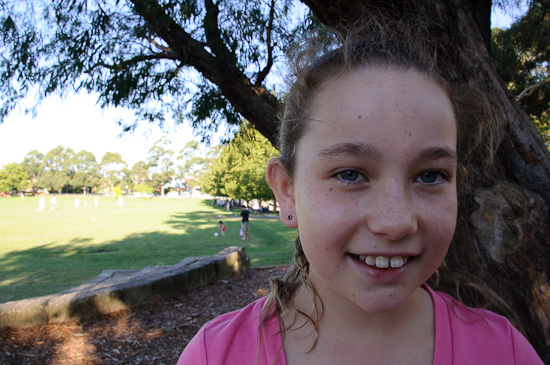
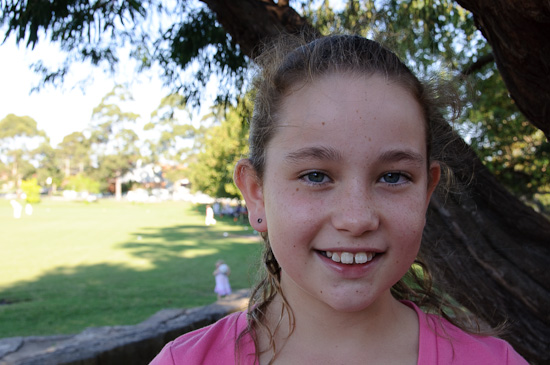
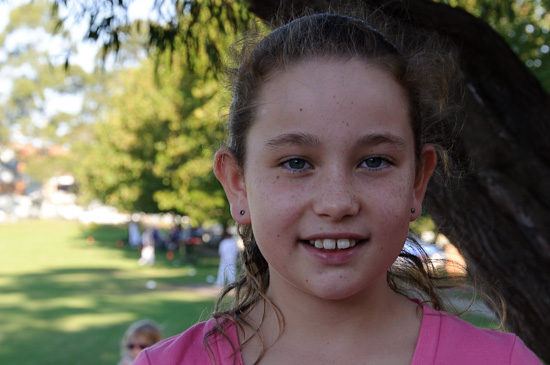
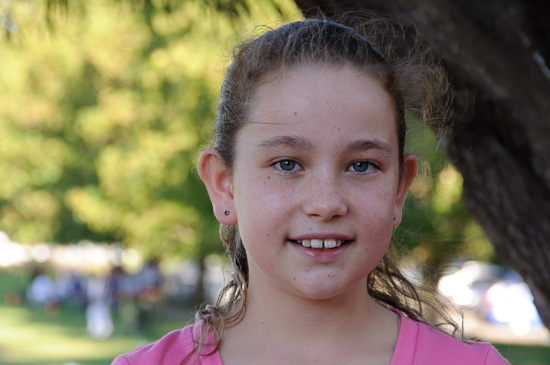
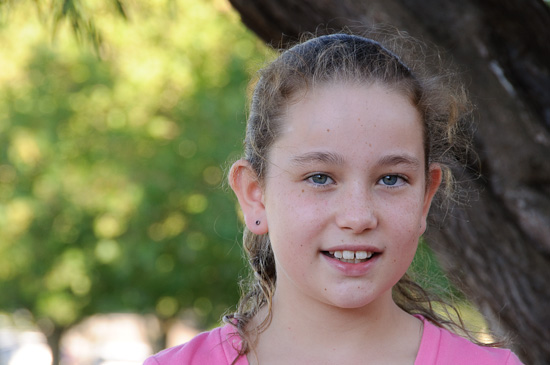







May 14th, 2010 on 3:36 am
Those are some terrific images, wish mine were that decent!
December 22nd, 2010 on 7:46 am
I am so lucky to find this great blog.Really I appreciate your work.Thanks for sharing this topic.
January 30th, 2011 on 1:13 am
You do a great job here.really very nice blog.thanks man for sharing this post
February 5th, 2011 on 2:01 am
Nice article, invoice. I will bookmark because this article provides interest information.
October 10th, 2011 on 2:03 pm
Well written article, really like, I hope to write some very useful articles such as.
October 31st, 2011 on 3:34 am
Great Post!. I think that my opinion is very similar to yours. I hope that you still share your opinion.
November 11th, 2011 on 8:00 am
very informative article, like the photos showing the depth of field by using longer lens.
November 13th, 2011 on 12:35 am
A língua portuguesa é a melhor. Esse post é lindo. Gostei muito. Realmente excelente. Continue escrevendo bem assim. Meu amigo.
January 24th, 2012 on 9:01 am
Howdy! I simply would like to give an enormous thumbs up for the great data you’ve got right here on this post. I might be coming again to your blog for more soon.
February 6th, 2012 on 7:25 pm
great post cheers from brazil
May 25th, 2012 on 6:24 pm
Very usefull weblog. i will follow this weblog. maintain up the very good work.
July 22nd, 2012 on 9:40 pm
Thanks for sharing excellent informations. Your web site is very cool. I’m impressed by the details that you have on this web site. It reveals how nicely you understand this subject. Bookmarked this website page, will come back for extra articles. You, my friend, ROCK! I found just the info I already searched all over the place and just could not come across. What a perfect site.
November 18th, 2012 on 11:02 pm
Hello, thanks for this usefull article. I added you to my favourites.